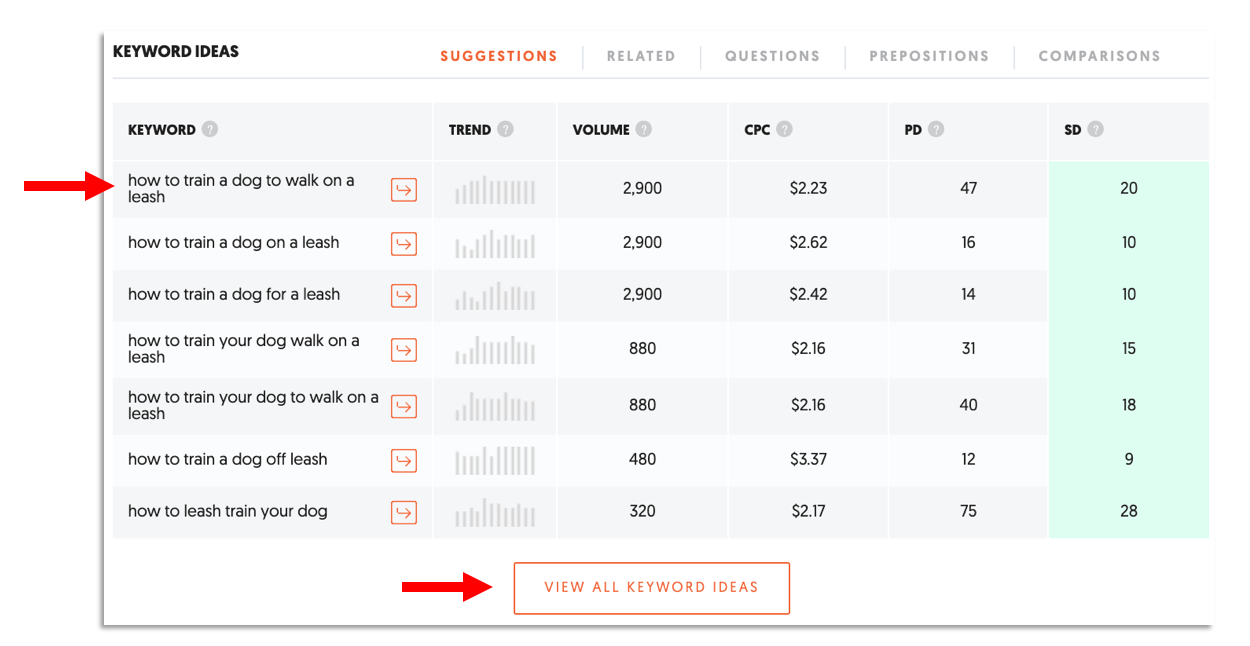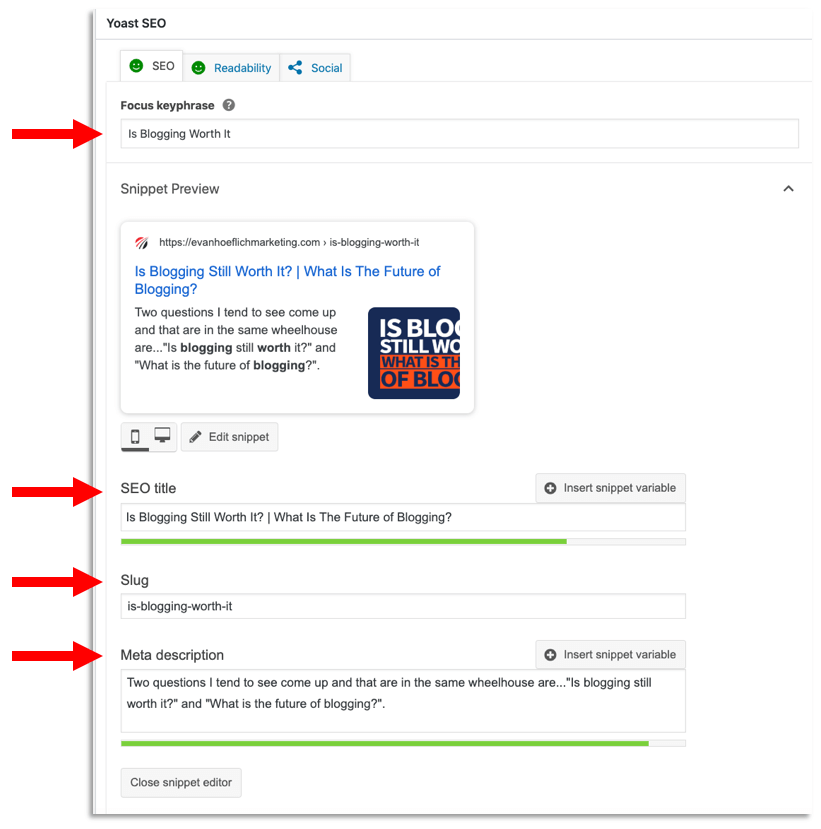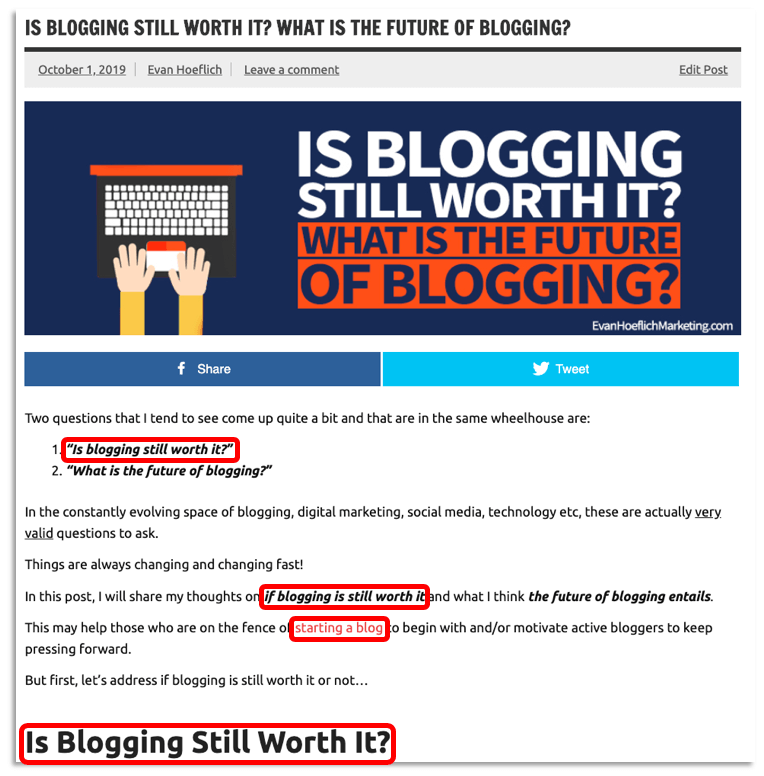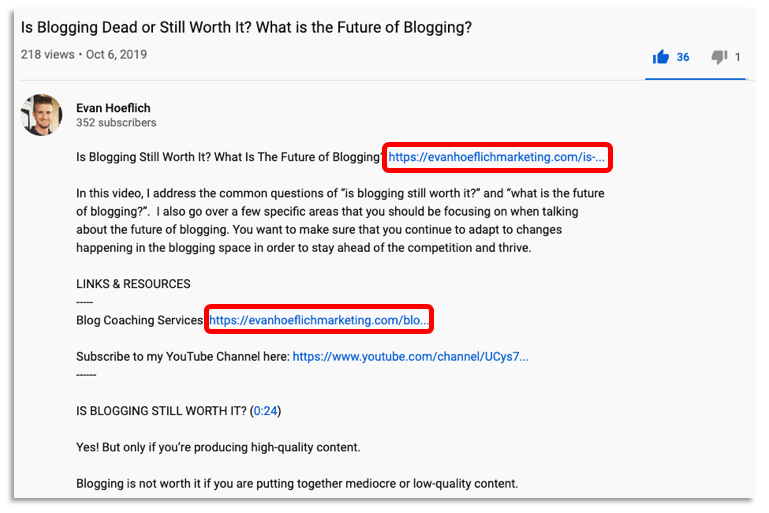How to Get More Blog Followers Organically (Using SEO Tactics)

If you’re a blogger struggling to build an audience, readership and following then I think this post will be helpful for you.
Every single blogger I work with wonders how they can get more blog followers so that they can grow their brand and business.
With so much information out there online, it can be confusing and even overwhelming to know where to start.
In this article today, I want to keep it simple and go over how to generate blog followers using one single strategy…
Search Engine Optimization (SEO)!
SEO involves optimizing your website and blog posts properly so that you can rank highly for certain keywords in the major search engines like Google, Bing and Yahoo.
This in return can bring you in loads of targeted traffic and dramatically increase your blog following.
Below you will find specific SEO steps you can take to get started as soon as this week.
But first, let’s go over why SEO is so important if you’re looking to generate more blog followers and increase your readership.
SEO Can Be Your Best Friend To Get More Blog Followers
SEO can be a major asset for your blog.
If done properly and consistently overtime, you can really drive lots of organic traffic to your website for months and years to come.
You can even reap the rewards of SEO work you implemented way in the past.
For example, I have certain blog posts I’ve written and optimized over 3 years ago that are still ranked highly within Google search today and bring daily visitors to my website (resulting in more email subscribers, affiliate sales, coaching clients and revenue).
When you realize this power, it should get you excited and motivated to practice the tips laid out below for yourself.
 Although you do not need to invest money to get started with SEO (since anyone can learn this on their own using helpful articles like this or other free resources), you will need to invest your time to study, learn, and get comfortable implementing certain SEO tactics.
Although you do not need to invest money to get started with SEO (since anyone can learn this on their own using helpful articles like this or other free resources), you will need to invest your time to study, learn, and get comfortable implementing certain SEO tactics.
With that being said, if you’d rather cut the learning curve by a large margin and get up to speed much quicker, I do offer SEO coaching here.
But again, it’s absolutely not required and especially if you have the time and interest to learn SEO on your own.
Organic visitors coming into your website from the search engines can be one of the highest quality traffic sources for a blogger.
Generally if people are finding your content using a certain search query in Google, chances are the blog post that’s presented to them is very relevant and targeted to their search.
As long as you’re producing high-quality content, this is a sure fire way to get more blog followers and build a loyal audience.
And if you stack this up over dozens or even of hundreds of blog posts (getting them ranked in Google), the sky is the limit in terms of how large your blog and business can grow to become.
Now let’s get into specific steps on how you can begin optimizing your content and website to generate more blog followers.
How to Get More Blog Followers Using Search Engine Optimization (SEO)
1.) Target the Right Keyword(s)
One of the most common mistakes I see beginner bloggers make is that they target keywords that are far too broad or competitive in nature. They wonder why they cannot rank any of their content in Google, but fail to realize that they are targeting the wrong types of keywords. Instead, try to focus on longer-tail keywords which have 3, 4, 5 or even more words in a given phrase. For example, instead of crafting a blog post around the word “dog training” you may want to instead target a keyword such as “how to train a dog to walk on a leash” within your content. This longer-tail keyword phrase is going to be far less competitive and easier to rank.
Now this is just an example, you will indeed want to get into the habit of conducting keyword research for yourself and your blog content using a free tool such as Ubersuggest. This way you can look into the monthly search volume, competition/difficulty of a keyword etc. A tool like Ubersuggest (there are paid tools out there as well such as Keywords Everywhere, Ahrefs and MOZ) will also reveal additional keyword ideas that you can possibly target and analyze as well (see screenshot below).

Keyword research using Ubersuggest.
2.) Incorporate These Phrases Into Your Blog Title, URL & SEO Tags
Once you have your main keyword(s) picked out for a blog topic, you will want to naturally incorporate the phrase(s) into your blog title, URL and SEO tags. I say naturally, because the last thing you want to do is “keyword stuff” or “jam” your keywords into your blog posts and meta data. Yes we are optimizing our content to get ranked ranked in the search engines, but we are also optimizing it for human visitors as well. You should strive to maintain a nice balance here.
- BLOG TITLE: Try to place your main keyword or a variation of your main keyword into your blog title which is generally your H1 tag. You also want this to be enticing to human visitors as well. For example, a blog post I wrote where my main keyword phrase was “Is Blogging Still Worth It”, I adjusted the title of that post to be “Is Blogging Still Worth It? What is the Future of Blogging?”. This way I still have my target phrase in there, but I also made this intriguing to human visitors who may stumble upon this doing a Google search.
- URL: You want to attempt to get your keyword (or a variation of it) into your URL as well. However, we do not want our URL slug to be too long since this can look sloppy or unnatural to Google. This can sometimes be tricky if you have a longer keyword phrase you’re targeting so use your best judgment here. At the very least, try to get a few of your buzzwords into your URL (example: https://evanhoeflichmarketing.com/is-blogging-worth-it).
- SEO TAGS: Below is a quick description of the SEO tags to focus on. If your blog is built on WordPress, I reccomend the plugin Yoast which will make the SEO tag process a lot easier (see screenshot below).
- Title Tags (“SEO Title” in Yoast): You will definitely want to place your main keyword phrase into your title tag. Sometimes you will even have room to add an additional keyword here since you have up to 70 characters to work with. Again, make this natural but at the same time it’s important that you give Google a good idea of what you’re trying to rank for by adding in your main term(s). The title tag is the blue clickable text seen in the search results when performing a Google search. So you will also want to make your title tag is compelling to encourage users to click-through to your website.
- Meta Descriptions: The meta description is seen underneath the title tag in the search results and explains what the page or post is about to users. It’s a good idea to add your keyword within your meta description once and also make sure it flows naturally within this snippet of text. Your meta description should also be enticing and persuade people to visit your blog post to read the full article. Utilize Yoast’s colored bars to help you with the length of your meta description (or a good range to shoot for is 145-160 characters long).
- Header Tags: Header tags include your h1, h2, h3, h4 and so on. These are the main headings above a given area of text within your blog content. Header tags also hold a lot of weight in regards to SEO (just like your title tag). They are seen directly within your blog content, so make sure that you do not keyword stuff here either. Instead naturally weave your keyword phrases into your header tags where they make sense for the best results.
- Image ALT Tags: Each image you place within your blog content can be tagged with an image alt text. When you click on your image within WordPress, always add a keyword rich alt tag in the section that says “alternative text”.
- Focus Keyword: Lastly, Yoast gives you the opportunity to add a “Focus Keyword” to your blog post. For this, simply place the main keyword you’d like to target in this section.

3.) Create Detailed, Long-Form & Comprehensive Content
A lot of times you hear the saying “content is king”, but I like to modify that to “quality content is king”!
This is especially true today more than ever when it comes to ranking your articles highly within the search engines. Google is looking to share content with users that is highly relevant, helpful and comprehensive. Essentially they want to direct people to the most valuable content possible as this provides a positive search experience. What this means to us bloggers is that we really need to focus on creating content that is going to provide solutions, answers and clarity to readers. Try to cover a subject in its entirety and put yourself in the readers shoes when planning your content. Also strive to make this content “longer-form” of at least 1,500 words or more. To break up your text and make it more visually appealing, you can utilize bulleted lists, numbered lists, header tags (h1, h2, h3, h4 etc.), images, videos etc. This type of high-quality and engaging content will give you the best shot at ranking your blog posts highly in Google.
4.) Optimize Content Properly with Keywords & Internal Links
Either during or after you write a blog post, you will want to make sure you’ve added in your target keyword phrases into the content where appropriate. As discussed in prior steps, make this natural and only add target keywords where they make sense. You do want to make sure however that you give Google enough of an idea of what your blog post is about and what you’re trying to rank for. This step will get easier with the more optimized content you write and eventually it should become second nature.
You will also want to insert a handful of internal links that point to other relevant or helpful articles on your website (using relevant anchor text as well). This is a great SEO strategy to spread powerful link juice throughout your website. It can also help with bounce rates and allows users to effectively navigate your blog content.

5.) Guest Post Like Crazy
Guest posting is an awesome SEO strategy to learn and master. If you’re wondering what exactly guest posting is, it’s the simple process of finding other blogs within your general niche and submitting a unique article to be published on their website. Within your guest post you are generally allowed a link to your website in the content or in the author bio section. There are many benefits of guest posting but the two biggies are:
- Guest posting helps your SEO by building you a quality backlink and improving your search engine rankings overtime.
- Guest posting can also drive more referral traffic to your website by people clicking on your link within your published article. This is free traffic that can really increase your overall brand awareness.
It’s important with guest posting that you try to do this on a consistent basis for the best results. Guest posting is a really powerful method that can explode your organic traffic and also referral traffic. Over the long term, this can significantly increase your blog following. I recorded a step-by-step tutorial here on how to do this for yourself…(I would love it if you could “Like” my video and subscribe to my channel for support! I publish helpful blogging, internet marketing and SEO videos on a monthly basis.).

Example of a backlink built via guest posting.
6.) Don’t Forget About YouTube SEO
Another big mistake I see with many bloggers is that they don’t utilize YouTube or do not have a YouTube channel to begin with. Much of this is based off of fear of getting in front of a camera, being vulnerable and so forth but YouTube content creation gets more and more comfortable with time. There is so much attention and people surfing YouTube on a daily basis, that bloggers are crazy not to leverage the platform to grow their blog following and business. The more organic traffic you can produce from YouTube, the more blog followers you will generate. You can use similar techniques to optimize your YouTube videos as discussed above by doing proper keyword research, adding your keywords into your title, video description and tag section. User engagement is also super important when it comes to YouTube SEO, so make sure you are encouraging people to “like”, “comment” and “subscribe”.
You will also want to embed your videos within your blog posts and share them on social media. Lastly, place links within your video descriptions to point people to helpful articles on your blog, services or even a capture page to build your email list (see screenshot below). The more visitors you can drive to your website from people clicking on your links within your videos descriptions, the more potential blog followers your will gain.
 YouTube SEO Power Tip: Transcribe each and every one of your videos for an added SEO boost.
YouTube SEO Power Tip: Transcribe each and every one of your videos for an added SEO boost.
7.) Consistency Is Key
Last but not least, you really need to be consistent in your blogging and SEO efforts in order to gain more followers. Realize that not every blog post you write will rank highly in Google. However, the more quality content you produce, the better chance you give yourself at driving more targeted visitors to your website. Try to publish at least 1-2 pieces of high-quality content to your blog per month. If you could do more, that’s excellent but do not sacrifice quality here. As long as you’re being consistent, this will send a strong signal to Google that your website is constantly updated with fresh and unique content.
If you’re interested in one-on-one blog coaching, get in touch with me here to see if you’d be a good fit for my program!
What strategies are you currently using to get more blog followers?

Hello. Your article is very informative and technical at the same time. I read it all the way through very carefully. I am doing my best to implement your recommendations on my blog and I hope to achieve good results. I only recently discovered this seo blog and I am glad I did. I will definitely read more articles. Congratulations on the blog and best wishes!